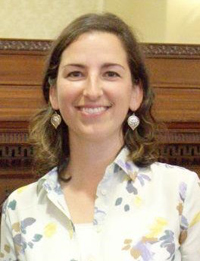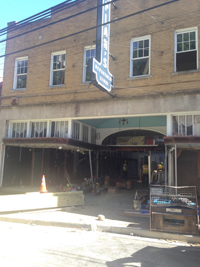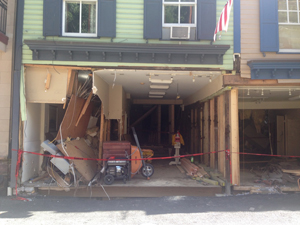Renee S. Novak, Field Director, Preservation Maryland
 Renee S. Novak received her Master’s Degree in Historic Preservation from the School of Architecture, Planning, and Preservation at the University of Maryland, College Park. She has worked in the private sector for both architectural and cultural resource firms in Baltimore City, where she participated in adaptive-use and transportation-related projects. During her undergraduate years at Mary Washington College’s Historic Preservation program, she interned with the federal government at Aberdeen Proving Ground’s Department of Cultural Resources in their Environmental Conservation and Restoration Division. She has also worked with the Maryland Historical Trust, the State Historic Preservation Office, as a Tax Credit Review Officer in the Office of Preservation Services. Her primary role there was to assist homeowners, business owners, architects, and the general public with the review and approval process for historic residential and commercial tax credit projects throughout Maryland. Most recently, Ms. Novak has served as the Field Director for the Preservation Maryland Preservation Resource Center on Main Street, Ellicott City, guiding rebuilding efforts of historic properties and helping to assist property owners and businesses with navigating the review process.
Renee S. Novak received her Master’s Degree in Historic Preservation from the School of Architecture, Planning, and Preservation at the University of Maryland, College Park. She has worked in the private sector for both architectural and cultural resource firms in Baltimore City, where she participated in adaptive-use and transportation-related projects. During her undergraduate years at Mary Washington College’s Historic Preservation program, she interned with the federal government at Aberdeen Proving Ground’s Department of Cultural Resources in their Environmental Conservation and Restoration Division. She has also worked with the Maryland Historical Trust, the State Historic Preservation Office, as a Tax Credit Review Officer in the Office of Preservation Services. Her primary role there was to assist homeowners, business owners, architects, and the general public with the review and approval process for historic residential and commercial tax credit projects throughout Maryland. Most recently, Ms. Novak has served as the Field Director for the Preservation Maryland Preservation Resource Center on Main Street, Ellicott City, guiding rebuilding efforts of historic properties and helping to assist property owners and businesses with navigating the review process.
What led you to your field?
I had originally wanted to be an architect and quite often found myself drawing inspiration from classical styles and researching historic buildings for my project designs. The mandatory architectural history classes were a favorite of mine. When I found that I could earn an actual Bachelors degree in “historic preservation” at Mary Washington College (now University of Mary Washington) in Virginia, I quickly changed my major and transferred with a focus in architecture. At that time (1996), I believe there were only a handful of preservation degree programs in the country. The area where I grew up, rural Harford County, Maryland, is rich in architectural and archaeological heritage, which always had me thinking of how to sustain these resources. So, instead of designing brand new buildings, I wanted to be part of the movement to save, preserve, and protect what’s left of the historic environment.
How does what you do relate to historic preservation?
So much of what I do relates to the historic preservation field; in fact, people’s every day actions relate in some way to preservation. I was recently a part of the large recovery effort for flood-damaged Ellicott City, a historic mill town in Maryland. My role there was to provide technical preservation assistance immediately after the flood for business and property owners, and to work with local non-profits and governmental agencies to make sure that preservation concerns were heard. Since my background in preservation involved the review of commercial and residential tax credit projects through working at the Maryland Historical Trust, I was able to provide guidance for helping to rebuild historic properties in Ellicott City at the local, state, and federal levels. However, preservation is much more than preserving and protecting buildings; my career has crossed paths with environmental policy, planning and zoning, socio-economic and cultural heritage concerns, and transportation-related projects. It is a professional field that acts as an umbrella over other sub-fields.
Why do you think historic preservation matters?
Historic preservation matters because without it our built environment would have a completely different aesthetic. Significant archaeological resources would be lost if it weren’t for programs that specifically document these resources and provide measures for their protection. Especially over the last decade, preservation has helped to influence certain legislation as well as design guidelines, building codes, and environmental policies that have had major impacts on how projects are undertaken, from local to national levels. Preservation really has its teeth at the local level, and without it there would be no standards to design or even a means to incentivize the costly rehabilitation of historic properties.
What courses do you recommend for students interested in this field?
I would recommend that students take a broad range of courses to expand their knowledge in this field. The traditional courses in history, art, and architectural history are especially important because architecture and the environment were shaped by the social and cultural patterns of the past. Learning to differentiate between architectural styles and how buildings go together, as well as documentation of historic resources, are crucial for understanding best preservation practices.
Besides the obvious background in history, courses such as sociology and urban planning are useful in understanding development. Economics and real estate development can show the necessary financial tools of preservation put into practice.
Do you have a favorite preservation project? What about it made it special?
It would be hard to pick a single favorite preservation project; there are so many that come to mind here. In my career, I have worked for both the private and public sectors as well as a nonprofit now, and I’ve enjoyed having the opportunity to explore and participate in the revitalization of a wide variety of historic resources, from large 19th-century manor houses to Baltimore rowhomes with Formstone to rural tobacco barns to industrial warehouse complexes to a historic Main Street. When I worked as a preservation officer for the Maryland Historical Trust doing tax credits, the diverse nature of projects that came through the program usually involved having to get to know the property owners on a personal level beyond their applications. Site visits were often a chance to observe innovative preservation work being done and to communicate directly with homeowners to help them rehab their properties according to the Secretary of the Interior’s Standards for Rehabilitation. I have seen interesting technologies employed, and on the flip side, I’ve seen many design solutions that were not so preservation-friendly which gave me a chance to defend the historic character of the building or district. All of these experiences proved to be learning opportunities. I enjoy being part of a team that collectively reviews project proposals and discusses ideas for best practices.
Can you tell us what you are working on right now? As we approach the one-year anniversary of the July 30, 2016, flash flood that devastated Ellicott City’s Main Street, many preservation issues have come to light in its wake. For the past year, as the boots-on-the-ground Field Director with Preservation Maryland’s Resource Center on Main Street, I strived to help serve the community and provide a broad range of preservation assistance. My next task will be working directly with Howard County’s Department of Planning and Zoning to revise the local historic district design guidelines to be more user-friendly and to include new perspectives on these relevant topics such as flood resiliency, geothermal systems, exterior signage, landscaping, new construction, and replacement materials.
As we approach the one-year anniversary of the July 30, 2016, flash flood that devastated Ellicott City’s Main Street, many preservation issues have come to light in its wake. For the past year, as the boots-on-the-ground Field Director with Preservation Maryland’s Resource Center on Main Street, I strived to help serve the community and provide a broad range of preservation assistance. My next task will be working directly with Howard County’s Department of Planning and Zoning to revise the local historic district design guidelines to be more user-friendly and to include new perspectives on these relevant topics such as flood resiliency, geothermal systems, exterior signage, landscaping, new construction, and replacement materials.
How do you think the national historic preservation programs help your community?
For one, I think the national historic preservation programs can help open the door to a great deal of financial incentives for properties that are historically designated. Having worked many years in the complex world of tax credits, I have had the benefit of actually seeing commercial and residential projects from start to finish, and there is something very satisfying about that. Without the Federal Rehabilitation Tax Credit, especially when in combination with Statewide Tax Credit Programs, these buildings would be gone. Additionally, I have seen the benefit of having cultural landscape and archaeological resources be protected as a result of project undertakings that are reviewed under Section 106 for compliance.
Do you have advice for novice preservationists?
Be open to new opportunities and new experiences that present themselves. You never know where this field may take you, from working in archival research to volunteering with your local non-profit environmental or archeological group, it’s the personal connections that you make along the way that will help determine a path for your career. Don’t be afraid to take chances or to steer a little off course; this will give you some perspective within the profession.
The ACHP’s mission is “preserving America’s heritage;” can you give us an example of how your community is preserving its heritage?.
I live in the Catonsville area, which is adjacent to the surrounding community of Ellicott City, and it is full of historic charm and character making it a desirable place to live and raise a family. Bordered by the Patapsco State Park, Catonsville (named “Music City Maryland”) has a unique main street with an abundance of original homes, quaint tree-lined streets, and easy access to nature. The original Catonsville Elementary School, built in 1909 and located on Frederick Road, was recently abandoned when students were moved to another school building just a few blocks away on Bloomsbury Avenue. This 57,692-square foot school building was once the centerpiece of the small town, and when word got out about the possibility of it being demolished, the community came together and immediately formed a non-profit group to save it. As of today, the building has been placed on Baltimore County’s preliminary landmark list which means the County Landmarks Preservation Commission must review and approve any plans for changes or alterations to the building’s exterior. I’ve attended a few of these meetings, and this is just one example of how this community comes together in a grassroots effort to protect a beloved local historic landmark. Additionally, Catonsville strives to preserve its small-town feel by hosting one of the largest Fourth of July parades in the region, a tradition that has been in place here since 1947 and draws thousands of people to the town.
How does historic preservation play a role in responding to natural disasters? Historic preservation is a critical part of the response effort after a natural disaster. In recounting the lessons learned from early post-flood days in Ellicott City, Preservation Maryland had acted quickly along with the Maryland Historical Trust and local nonprofit groups to be part of the conversation for how to move the town forward after buildings and infrastructure were significantly destroyed. By establishing a resource center on Main Street and providing staff to directly assist business owners, property owners, local nonprofits, and government officials with complicated processes such as financial incentives for rebuilding and navigating the local design review and permits, Preservation Maryland helped to elevate preservation concerns in conjunction with local partners who were already established in the area. Not only was that an important role to play in the larger road to recovery but also highlights the need for coordination and partnership across a broad range of fields. Because the historic Main Street suffered terrible damage to its buildings, foundations, roads and waterways, all aspects of the rebuilding effort require some level of consideration for historic preservation. This is true for discussing appropriate replacement materials on the exterior and interior of historic buildings, repair of underground infrastructure, repair of sidewalks and original stone walls as part of the hardscape, and redesign of historic storefronts and building layouts to include new egress while adhering to design guidelines. One thing to keep in mind is that the joint effort to restore a town or place after a natural disaster will move quickly in relation to safety concerns, such as the early condemning of several historic buildings that were thought to be structurally compromised. In the case of Ellicott City, it took some creative thinking in order to intercede in the name of preservation and to make the case for saving resources from demolition.
Historic preservation is a critical part of the response effort after a natural disaster. In recounting the lessons learned from early post-flood days in Ellicott City, Preservation Maryland had acted quickly along with the Maryland Historical Trust and local nonprofit groups to be part of the conversation for how to move the town forward after buildings and infrastructure were significantly destroyed. By establishing a resource center on Main Street and providing staff to directly assist business owners, property owners, local nonprofits, and government officials with complicated processes such as financial incentives for rebuilding and navigating the local design review and permits, Preservation Maryland helped to elevate preservation concerns in conjunction with local partners who were already established in the area. Not only was that an important role to play in the larger road to recovery but also highlights the need for coordination and partnership across a broad range of fields. Because the historic Main Street suffered terrible damage to its buildings, foundations, roads and waterways, all aspects of the rebuilding effort require some level of consideration for historic preservation. This is true for discussing appropriate replacement materials on the exterior and interior of historic buildings, repair of underground infrastructure, repair of sidewalks and original stone walls as part of the hardscape, and redesign of historic storefronts and building layouts to include new egress while adhering to design guidelines. One thing to keep in mind is that the joint effort to restore a town or place after a natural disaster will move quickly in relation to safety concerns, such as the early condemning of several historic buildings that were thought to be structurally compromised. In the case of Ellicott City, it took some creative thinking in order to intercede in the name of preservation and to make the case for saving resources from demolition.
Read more Q&A stories about the preservationists in your neighborhood!